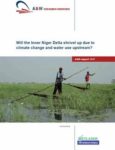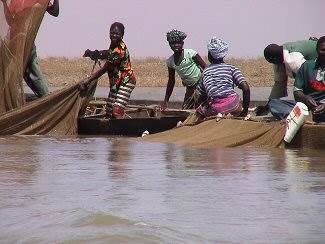When the climate will change in the Sahel, this will have an impact on the flooding of the Inner Niger Delta and, therefore, also on its ecological and economic functions. This report evaluates the human-driven changes in the hydrology of the Upper Niger and the possible additional impact of a climate change. The data sets used by Zwarts et al. (2005) are re-analysed and updated (as far as possible) for recent years: annual rainfall in the Upper Niger Basin, annual river discharge of Bani and Niger upstream of the Inner Niger Delta, water use (dams and irrigation schemes upstream of the Inner Niger Delta), and maximal annual flood extent of the Inner Niger Delta.

Will the Inner Niger Delta shrivel up due to climate change and water use upstream
downloadThe Inner Niger Delta in Mali is huge. On topographical maps from the 1960s, a total surface of 36,000 km2 is designated as floodplain. When the water level starts to rise in the southwestern part of the Delta in July, the plains in the northeast are still dry. By the time that the northern plains become flooded two months later, the water level is already receding in the south. The area covered by water at any one time amounts to 25,000 km2. Such a large flood extent is only possible when the combined inflow of Niger and Bani, the major tributaries, exceeds 55 km3 in the rainy season. In most years, the inflow is smaller.
During the disastrous drought in 1984, the inflow was only 15 km3, and the flood extent did not exceed 5500 km2. The Inner Niger Delta not only stands out because of its size, but also because of its hydrological dynamics. Between July and December the water rises by more than 6 m in wet years, and declines by the same amount in the following months. In extremely dry years, however, the flood level rises by only 3m.
Direct and governing impact on natural resources use
This large annual variation in flooding has a direct and governing impact on the natural resources in the Inner Niger Delta. The lower the flood, the lower the production of fish, rice and bourgou grass. The impact of a reduced river inflow on the ecological and economic functions of the Inner Niger Delta may be quantified, since the production of these natural resources is strongly related to the flooding, and the flooding is dependent on the inflow of the rivers. Zwarts et al. (2005) used this approach to evaluate the net present value (NPV) of the dams and irrigation in the Upper Niger Basin, taking into account these negative downstream impacts.

Impacts of climate change
When the climate will change in the Sahel, this will have an impact on the flooding of the Inner Niger Delta and, therefore, also on its ecological and economic functions. It would be misleading, however, to take the present hydrological circumstances as starting point for an extrapolation of the impact of the climate change on the flood extent. It would be misleading, since even without any change in the climate, the Inner Niger Delta will show a declining flood extent, due to new dams and extended irrigation schemes upstream in the Upper Niger Basin. That means that before a sketch can be given of the impact of a climate change on the flood extent of the Inner Niger Delta, it is necessary to start with a description of the expected decline in the flood extent of the Inner Niger Delta due to new dams and irrigation schemes upstream.
The study was done in the framework of the Wetland & Livelihoods Project: GIRE (Gestion integrée de Resources naturelles) dans le basin du Niger en amont de Taoussa)